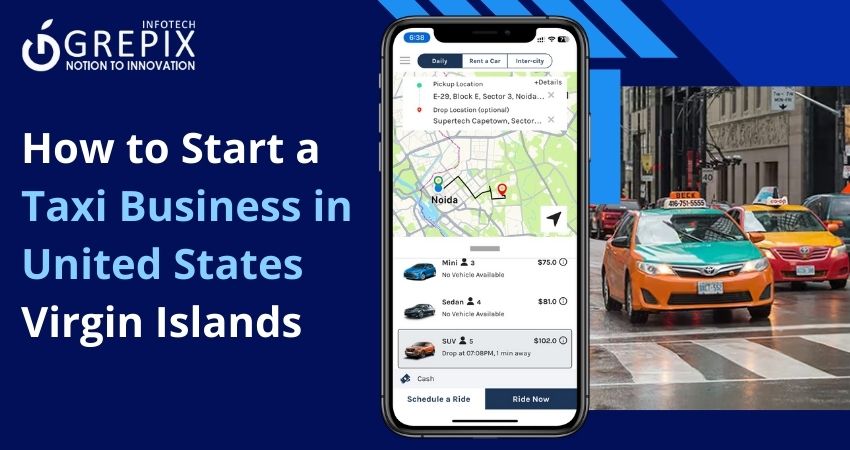How to Start a Taxi Business in United States Virgin Islands
If you're dreaming about turning the open roads and island breezes into a profitable venture, starting a taxi business in the United States Virgin Islands (USVI) might just be your perfect opportunity. With its steady influx of tourists, cruise ships, and a growing local population, the USVI presents a ripe market for transportation services. However, making your taxi dream a reality takes more than just buying a car and picking up passengers. From legal paperwork and licensing to understanding the unique business dynamics of island life, you need to get every aspect of the business right.
This detailed guide will walk you through every step no fluff, just actionable info. Whether you're a local resident looking to build a stable income or an outsider wanting to tap into the Caribbean transportation scene, you'll find everything you need right here. Buckle up, we're about to hit the gas on your future business journey.
Thinking of launching a taxi business in the United States Virgin Islands (USVI)? This comprehensive guide walks you through every crucial step, from understanding legal regulations and acquiring permits to choosing the right vehicle and crafting a solid business plan. The USVI, known for its tourism-driven economy, offers an excellent opportunity for transport businesses. However, navigating the local licensing requirements, startup costs, insurance policies, and business strategies can be tricky without the right knowledge. Whether you're a local entrepreneur or an investor looking for a steady income stream, this blog offers actionable insights to help you build a successful taxi service in this Caribbean paradise. Learn how to stand out from the competition, attract tourists and residents alike, and scale your taxi business efficiently with smart tools and marketing strategies. Ready to rev up your engines and turn this idea into a profitable venture? Let's dive in step-by-step!
1Understanding the Taxi Industry in US Virgin Islands
1. Tourism-Driven Market Dynamics
The USVI is a tropical magnet for vacationers. St. Thomas, St. John, and St. Croix welcome millions of tourists each year, and many of them rely on taxis for convenient island transportation. Unlike larger cities where public transport or rideshare apps dominate, taxis remain the backbone of transportation here. That's because not all areas are served by buses, and most tourists avoid renting cars due to left-side driving and unfamiliar terrain.
This reliance creates a golden opportunity for local taxi operators. High-traffic zones like airports, ferry docks, hotels, and cruise ship terminals practically guarantee a consistent stream of customers. If you position your business strategically in these zones, you can enjoy peak-season revenue spikes and build repeat clientele among returning tourists.
2. Demand from Locals and Expats
But it's not just tourists fueling the taxi economy. Many locals and expats prefer taxis for their daily transportation needs. While locals may own cars, not all do, and taxis serve as essential services during emergencies or special events. Meanwhile, expats living in villas or remote areas often depend on taxis for errands, airport transfers, or nightlife outings.
Adding services like school runs, medical appointments, and private hires can help diversify your income beyond tourist seasons.
3. Seasonal Peaks and Off-Season Strategies
Tourism in the Virgin Islands tends to peak from December through April. During this time, you can expect higher fares, more clients, and long shifts. But come the off-season, especially during hurricane months (June to November), traffic slows down significantly.
That's why it's smart to implement off-season survival strategies:
- Offer discounted packages to locals.
- Partner with local businesses for staff transport contracts.
- Advertise island tours or specialized services like wedding transport.
Building a year-round income stream is all about diversifying your offerings and marketing efforts wisely.
2Legal Requirements to Start a Taxi Business
1. Licensing and Permits
To legally start a taxi business, obtaining the necessary licenses and permits is essential. This typically includes a business license, vehicle permits, and commercial driver’s licenses for all drivers. Depending on your location, you may also need a taxi operator’s license and a special taxi plate or medallion. It’s crucial to comply with local transport regulations, which may involve vehicle inspections and background checks for drivers. Insurance coverage both for vehicles and passengers is mandatory. Always consult with local authorities or a legal expert to ensure full regulatory compliance before launching operations.
2. Taxi Operator License Process
In the USVI, you can't just slap a "TAXI" sign on your car and start driving. You need to apply for a Taxi Operator License, issued by the Department of Licensing and Consumer Affairs (DLCA) and the Taxicab Commission. The process includes:
- Submitting an application.
- Providing a clean police record.
- Passing a physical and drug test.
- Completing a defensive driving course.
- Paying applicable fees.
Once approved, you'll receive a badge that allows you to operate legally.
3. Taxi Medallion Requirements
Taxi medallions are like golden tickets. These licenses are limited and must be purchased or leased from existing medallion holders or through government auctions. Medallions are vehicle-specific and must be renewed regularly. They represent a significant investment but also give your business legitimacy and exclusivity.
4. Business Registration
Before you begin operations, your taxi business must be legally registered. You can register as a:
- Sole Proprietor
- Limited Liability Company (LLC)
- Corporation
Register with the Office of the Lieutenant Governor – Division of Corporations & Trademarks and obtain an Employer Identification Number (EIN) from the IRS.
5. Vehicle Registration and Inspection
Your vehicle must be registered with the USVI Bureau of Motor Vehicles and pass regular inspections. The car must:
- Be clean and well-maintained.
- Have a working meter or rate card.
- Be clearly labeled as a taxi.
Inspections ensure the safety of passengers and keep your license in good standing.
3Choosing the Right Vehicle
1. Vehicle Type Best Suited for USVI Roads
Not all vehicles are ideal for island driving. The terrain in the USVI can be steep, uneven, and narrow in places. That means compact SUVs, vans, and 4x4s are popular choices. They provide enough space for passengers and luggage while being sturdy enough for hilly roads and occasional potholes.
Avoid low-clearance sedans or gas guzzlers—they'll cost more in maintenance and fuel.
2. Fuel Efficiency and Comfort
Fuel is expensive on the islands, so choosing a vehicle with great gas mileage is critical. Hybrid models are growing in popularity, especially for eco-conscious operators. Passengers also expect comfort, so invest in:
- Air conditioning
- Clean interiors
- Charging ports
- Luggage space
These details may seem small, but they lead to big tips and repeat business.
3. ADA Compliance Considerations
If you're aiming to win government contracts or serve a broader clientele, consider investing in at least one ADA-compliant vehicle. These are equipped with wheelchair lifts and accessible seating. It's not just good practice, it's an untapped market with potential grant support.
4Creating a Business Plan
1. Setting Objectives and Goals
Before you hit the road, you need to map out your route—figuratively speaking. Your business plan is the blueprint for success. Begin with defining:
- Your short-term and long-term goals
- Your service area (which islands, what routes)
- Target clientele (tourists, locals, businesses)
Clarity here guides your decisions on hiring, pricing, and marketing.
2. Budget and Startup Capital
How much will your dream cost? Here are some rough startup costs:
- Vehicle: $15,000–$30,000
- Licensing/Medallion: $5,000–$25,000 (varies)
- Insurance: $2,000–$5,000 annually
- Marketing: $1,000+
- Misc. (fuel, branding, maintenance): $3,000
If you don't have this upfront, explore business loans or partnerships.
3. Competitive Analysis and USP
Scope out the competition. Are there many taxis in your area? What can you offer that others don't? Maybe it's:
- 24/7 service
- Online booking
- Themed island tours
- Luxury or eco-friendly rides
Your Unique Selling Proposition (USP) is what sets you apart and helps your brand stick in people's minds.
5Estimating the Startup Costs
1. Vehicle Purchase or Lease
Your vehicle is your business's most essential asset. You can either purchase a car outright or opt for a lease. Both come with pros and cons:
- Purchasing gives you full ownership and eliminates monthly lease payments. However, it requires a significant upfront investment.
- Leasing can be easier on your cash flow initially, but you may face mileage limits or pay more long-term.
In the USVI, expect to pay between $15,000 and $30,000 for a reliable, taxi-ready vehicle. If you're considering a used vehicle, ensure it meets the local standards and passes inspection. Vehicles should ideally be newer than 5 years old, especially in high-end tourist zones.
Factor in the cost of modifications like decals, roof lights, or metering systems.
2. Insurance and Licensing Fees
Don't underestimate the cost of compliance. In the USVI, licensing fees vary depending on your business structure and medallion acquisition. If you're purchasing a medallion through a government auction, expect prices from $20,000 to $30,000, depending on the island.
Insurance is another recurring expense. You'll need:
- Commercial auto insurance
- Liability coverage
- Medical coverage
Expect to pay $2,000 to $5,000 annually depending on vehicle type, driver history, and coverage level.
3.Marketing and Operational Expenses
Branding and promoting your business is non-negotiable. Whether you go with printed flyers, social media ads, or partnerships with local tourism boards, set aside at least $1,000 to $3,000 for initial promotions.
Operational expenses include:
- Fuel
- Maintenance
- Mobile phone/data plans
- Booking software
- Driver uniforms or gear
Build a buffer of at least $3,000 to $5,000 to cover these costs during your launch phase.
6Understanding Local Transportation Laws
1. USVI Taxi Commission Rules
The Virgin Islands Taxi Commission is the governing body that oversees taxi services across the territory. They ensure fair pricing, vehicle safety, and proper driver behavior. As a taxi business owner, staying compliant with their rules is crucial. Common regulations include:
- Fixed fare schedules (you can't randomly charge rates).
- Approved vehicle types and conditions.
- Proper signage and visible licensing.
Violating these can lead to hefty fines or license suspension.
2. Zoning and Operational Hours
Not every part of the USVI allows unrestricted taxi operation. Some areas have zoning laws that limit how or where you can pick up passengers. For example, picking up fares at the airport or ferry terminals may require special authorization or be limited to specific license holders.
Likewise, some beaches or resorts restrict access to authorized taxis only. Know the areas you're permitted to operate in and during what hours.
Ensure your business fits within the local taxi zoning maps and get clearance if you intend to operate in restricted zones.
3. Penalties for Non-Compliance
The Taxi Commission doesn't play around. Common penalties include:
- Fines ranging from $100 to $1,000 for noncompliance.
- Vehicle impoundment if operating without a license or medallion.
- Suspension of your operator license for misconduct or unprofessional service.
To avoid issues, keep up with renewals, pay dues on time, and treat customers respectfully.
7Getting Insurance Coverage
1. Commercial Auto Insurance
Your personal car insurance won't cut it here. You'll need commercial auto insurance specifically tailored for transporting paying customers. This covers:
- Vehicle damage
- Passenger injuries
- Property damage in case of accidents
Costs depend on the type of vehicle, driving record, and coverage limits, but budget $2,500 to $4,000 per year.
2. Liability Insurance
This is especially important if a customer claims you caused injury or loss. General liability coverage helps protect your business from lawsuits and expensive legal claims. Some government or corporate contracts won't even consider you without this in place.
Minimum liability limits should be $1 million, especially if you plan to serve cruise ports or larger resorts.
3. Employee Insurance if Hiring Drivers
If you're not the sole driver, you're likely required to provide workers' compensation insurance. This protects both you and your drivers in case of injury while on the job. Even part-time or freelance drivers might need to be covered, depending on your employment model.
Check with a local insurance broker to customize a package that fits your setup.
8Branding and Marketing Your Taxi Service
1. Creating a Catchy Business Name
Your name is your brand's first impression—make it memorable! Something like "Island Glide Taxi" or "Caribbean Cab Co." works better than generic names like "John's Taxi." It should evoke professionalism, trust, and island vibes.
Make sure the name:
- Is easy to pronounce.
- Is unique and not already in use locally.
- Has an available website domain.
Once chosen, register it with the USVI Division of Corporations and secure matching social media handles.
2. Building an Online Presence
Having a digital footprint is no longer optional—it's essential. Build a basic website with:
- Your services
- Contact information
- Online booking form
- Customer reviews
- Google Map location
Also, list your business on:
- Google Business Profile
- TripAdvisor
- Yelp
- Local tourism directories
Use platforms like Facebook and Instagram to post content—behind-the-scenes videos, local tips, or customer testimonials.
3. Partnering with Hotels and Resorts
Forming alliances with resorts, villas, and tour operators can secure steady business. Offer them a commission for every referral or a set discount. Consider printing business cards or flyers to leave in hotel lobbies.
You can even offer:
- Flat-rate hotel transfers
- Sightseeing tours for guests
- Priority pick-up for partnered hotels
These partnerships can become the backbone of your customer base.
9Using Taxi Booking Apps and Technology
1. GPS and Digital Metering Tools
Modern customers expect convenience, and you'll need to integrate technology that improves both service and trust. Equip your vehicle with:
- GPS for efficient routing.
- A digital fare meter or fixed-rate card displayed.
- Dashcams for safety and liability protection.
Using tools like Waze, Google Maps, or TaxiCaller can help manage logistics.
2. Mobile Payment Systems
Cash-only businesses are fading fast. Tourists, especially, prefer card payments. Accepting payments through:
- Square
- PayPal Zettle
- Clover Go
- Contactless NFC systems
Set up mobile receipts to send via SMS or email after each ride.
3. Custom App Development or Joining Platforms
If you want to go big, consider developing your own taxi booking app, complete with fare estimates, driver tracking, and ride history. This works well if you plan to scale and dominate an island or region.
Not ready for that? Join a third-party dispatch platform if available locally or work with hotel concierge systems to schedule rides through their networks.
10Hiring and Training Drivers
1. Screening and Licensing Drivers
If you plan to expand beyond being a solo driver, hiring the right team is essential. The first step? Thorough background checks. You want drivers who are:
- Trustworthy
- Courteous
- Familiar with local roads and tourist hotspots
Each driver will need to hold a valid Taxi Operator License and possibly a Commercial Driver's License (CDL), depending on the vehicle size. Be sure they pass a drug test and physical examination, as required by the Taxi Commission.
Also, consider drivers with prior customer service or tourism experience. A friendly personality can be the difference between a one-time ride and a five-star review.
2.Customer Service and Safety Training
Once hired, invest in training that covers:
- Professional conduct and communication
- Handling difficult passengers
- Emergency procedures (medical, mechanical)
- Island-specific safety laws
It's also smart to develop a driver handbook covering all expectations, route guidance, fare policies, and dispute resolution procedures.
A well-trained driver can serve as your brand ambassador. They represent your company every time they pick up a fare.
3. Incentives for Driver Retention
Driver turnover can hurt your business. To retain your team, offer:
- Performance-based bonuses
- Flexible schedules
- Weekly payout options
- Referral bonuses for new drivers
Create a culture that values and supports your team, and they'll be more likely to stick around.
11Launching Your Taxi Business
1. Soft Launch Strategy
Don't go all-in immediately. A soft launch lets you test your operations, address hiccups, and gather customer feedback. This could be:
- Operating in a limited zone (airport or port only)
- Working limited hours
- Offering services to friends and family for reviews
Track how many calls you get, where the demand is strongest, and how well your systems hold up.
2. Promotions and Discounts
To attract early adopters, use:
- First-ride free coupons
- Discounted airport transfers
- Refer-a-friend bonuses
- Loyalty cards for locals
Give your customers a reason to choose you over competitors especially early on when brand recognition is low.
Pair discounts with good service and you'll build loyalty quickly.
3. Community Engagement and Awareness
In a close-knit place like the USVI, word-of-mouth is powerful. Get involved in:
- Local events
- Chamber of Commerce meetups
- School fundraisers
- Tourism board partnerships
Sponsor an event or offer free rides to local charities, it's great publicity and shows your business supports the community.
12Managing Daily Operations Efficiently
1. Scheduling and Dispatch
Whether you're running solo or managing a small team, efficient dispatch is critical. You can:
- Use manual scheduling via spreadsheets or whiteboards
- Leverage tools like TaxiCaller, Book Rides Online, or FarePilot
These tools help assign drivers, track routes, log rides, and manage bookings without chaos.
Also consider peak-hour management ensure more drivers are available during cruise ship arrivals or evening rush hours.
2. Maintenance and Fuel Tracking
A poorly maintained car is a liability and a loss waiting to happen. Create a vehicle maintenance checklist and enforce:
- Weekly inspections (tires, brakes, fluids)
- Monthly deep cleaning
- Annual full service
Use apps or fuel cards to track mileage and gas usage, helping cut unnecessary costs and detect early problems.
3. Customer Feedback and Issue Resolution
Encourage feedback after every ride either through SMS follow-ups, online reviews, or feedback cards. Happy riders boost your credibility. For those who aren't happy, a quick response or compensation can turn a critic into a fan.
Track complaints, train staff to resolve them quickly, and use the data to improve future operations.
13 Scaling Your Business
1.Adding More Vehicles
Once you've nailed operations and built a steady flow of business, it's time to expand your fleet. Options include:
- Buying new vehicles outright
- Leasing additional cabs
- Letting other licensed drivers join your brand
Make sure all vehicles match your brand's look and feel. Uniformity builds trust and recognition.
Set performance benchmarks before scaling like achieving 80% ride capacity or consistently hitting profit margins.
2. Expanding to Other Islands or Services
St. Thomas is the hotspot, but St. John and St. Croix also offer untapped potential. Consider opening operations on those islands or offering inter-island transportation coordination.
You could also add:
- Tour packages
- Airport shuttle vans
- Wedding/event transport
- Executive luxury rides
Diversifying services protects your business from seasonal slowdowns.
3. Forming Fleet Partnerships
You don't have to grow alone. Partnering with other drivers or small operators under one brand can help scale faster. Create a revenue-sharing model or franchise setup.
This way, you increase reach without the burden of owning and managing every car yourself.
14Challenges to Expect and How to Overcome Them
1. Competition
It's likely you'll face stiff competition especially near cruise terminals, airports, or hotel clusters. Instead of racing to undercut prices, focus on your customer experience:
- On-time service
- Clean, modern vehicles
- Friendly drivers
- Online booking availability
These elements are harder to copy and build long-term customer loyalty.
2. Regulatory Changes
The Virgin Islands' government occasionally updates its taxi rules. Stay informed through:
- The Taxi Commission's website
- Local business networks
- Online forums or associations
Consider hiring a local legal advisor if you scale up staying ahead of regulation gives you an edge.
3. Mechanical and Staffing Issues
Island terrain can wear down vehicles fast. Budget for high maintenance and always keep a backup car if possible.
As for staffing vacation schedules, burnout, or personal issues can leave you short-handed. Maintain a pool of part-time drivers or have a driver-on-call system in place.
Cross-training staff in multiple roles (dispatch, driving, admin) can help plug gaps in emergencies.
Conclusion
Starting a taxi business in the United States Virgin Islands is more than just buying a car and driving people around, it's a journey that involves careful planning, strategic investments, and continuous learning. The blend of a booming tourist economy and a strong local demand makes this a highly attractive opportunity, but it also comes with its fair share of challenges
As a leading taxi app development company, Grepix offers a turnkey, white-label taxi solution that can launch your brand in as little as 5 to 7 days. You can focus on delivering excellent customer service, staying compliant with local laws, and using modern tools and marketing, you can carve out a reliable and profitable niche. The islands offer a beautiful setting to run a business, but the real beauty lies in your ability to serve both residents and visitors with care, convenience, and class.
Don't rush plan every step, keep your operations smooth, and remember: in this business, reputation is everything. A few great reviews can take you a long way, especially in a tight-knit island community.
So if you're serious about building a taxi empire in paradise start now, stay consistent, and ride your way to success.
FAQs
1. What licenses do I need to start a taxi business in USVI?
You'll need a Taxi Operator License from the USVI Taxi Commission, a business license from the DLCA, and possibly a medallion for your vehicle.
2. How much does it cost to start a taxi business in the Virgin Islands?
Startup costs typically range from $25,000 to $50,000, depending on your vehicle, licensing, insurance, and marketing efforts.
3. Can I lease a car for taxi use in USVI?
Yes, leasing is allowed as long as the vehicle meets the Taxi Commission's standards and is registered for commercial use.
4. Do I need special insurance to run a taxi in the USVI?
Yes, commercial auto insurance and liability coverage are mandatory. If you hire drivers, worker's comp is also recommended.
5. Is there a high demand for taxis in the Virgin Islands?
Absolutely! With millions of tourists and limited public transport options, taxis are in high demand year-round—especially during cruise season.
Looking out to start your own venture like Uber? Try out our HireMe Taxi Uber Clone, the easiest way to kick-start your taxi business.







